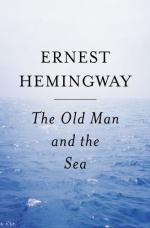|
This section contains 6,760 words (approx. 23 pages at 300 words per page) |

|
SOURCE: "Hemingway and the Christian Paradox," in Renascence: Essays on Values in Literature, Vol. XXIV, No. 3, Spring, 1972, pp. 141-54.
In the following essay, Hamilton examines the central, unifying symbols in The Old Man and the Sea—in particular the image of the fish, a Christian symbol — and argues that at the heart of the novella is the Christian paradox of man's search for God and God's simultaneous search for man.
Little of the attention given to The Old Man and the Sea has given adequate consideration to one feature: the great fish as the central, organic, symbolic center of the novel, from which hitherto unseen meanings radiate. The idea of the fish as an organic symbol has validity for Hemingway not only historically but intellectually, his anti-intellectual pose to the contrary notwithstanding. This interpretation of the novel is supported by Hemingway's religious stance both in statement and practice...
|
This section contains 6,760 words (approx. 23 pages at 300 words per page) |

|


